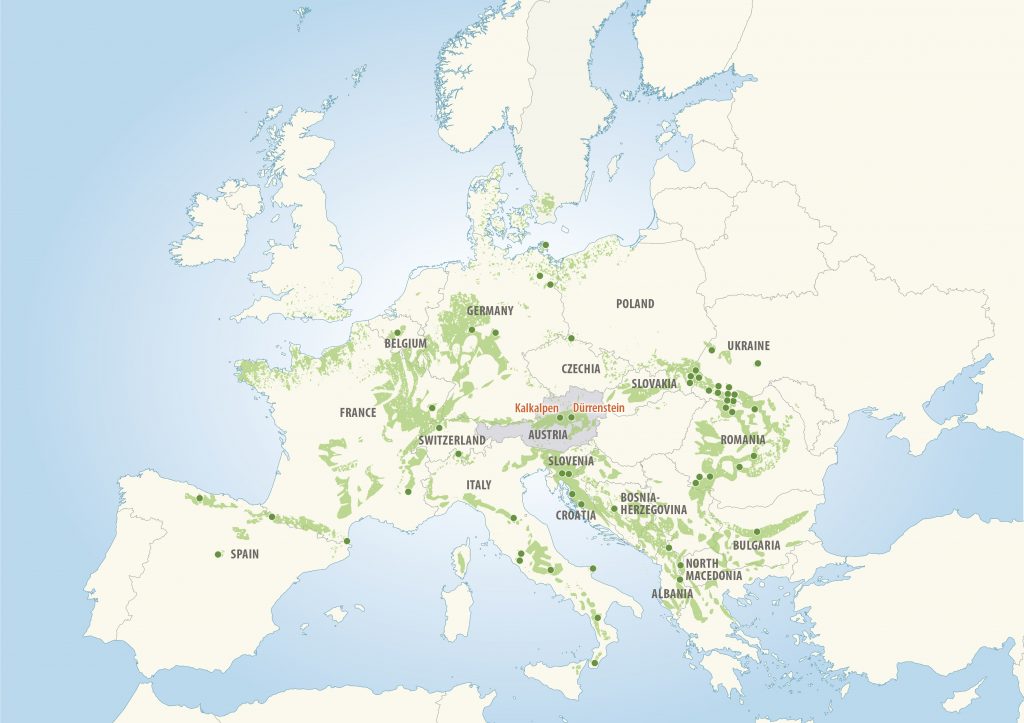The World Heritage Beech Forests gains new members
The largest serial World Heritage property gets even larger: Unesco World Heritage Series “Ancient and Primeval Beech Forests of the Carpathians and Other Regions of Europe” is extending with 6 additional States Parties.
The Unesco World Heritage Series “Ancient and Primeval Beech Forests of the Carpathians and Other Regions of Europe” is proud to announce its extension with 6 additional States Parties (Bosnia & Herzegovina, Czechia, France, North Macedonia, Poland and Switzerland). This extension adds 15 new protected areas to the network. And more precious forest areas in other countries could follow. The entire World Heritage Site comprises the few remaining European primeval beech forests and centuries-old European beech forest areas, which are almost unaltered by humans.
This World Heritage series is currently the largest serial World Heritage property. With 94 sites in 18 countries, it is the only World Heritage Site globally that connects so many component parts. It covers areas in Albania, Austria, Belgium, Bosnia & Herzegovina, Bulgaria, France, Germany, Italy, Croatia, Czechia, North Macedonia, Poland, Romania, the Slovak Republic, Slovenia, Spain, Switzerland, and the Ukraine. This requires collaboration across boundaries and illustrates the close relationship of the beech forest with European culture.
It all began in 2007 with the “Primeval Beech Forests of the Carpathians”, ten areas in the Slovak Republic and the Ukraine – thus a transboundary World Heritage from the very beginning. With the inscription of the “Ancient Beech Forests of Germany” on the World Heritage List in 2011, our World Heritage Site was extended by five component parts. In 2017, 63 additional areas in ten countries were added.
The European beech – a european endemic tree
The history of European beech forests begins around 10,000 years ago, after the end of the last Ice Age. Starting from several refuge areas, i. e. ice-free areas where the beech could survive, it conquered alomst an entire continent. To this day, it‘s expansion strength remains unbroken. It is still on the advance in southern Scandinavia as well as in the extreme west and north of the European beech Distribution area. This phenomenon is worldwide unique and is made possible by the enormous competitiveness of the beech.
Settlement activities and economic use have reduced Europe’s natural beech forests to only a few areas.
The last primeval beech forests
Beech forests are Europe’s natural wilderness. They cross national borders and connect Europe – if people allow them to. However, natural beech forests were pushed back significantly by human settlement and economic usage. The last large areas of these primeval forests are in the Carpathian Mountains. There are only a few remnants in the Alps. Centuries-old beech forests are now extremely rare and endangered in Europe.
The uniqueness and at the same time the worthiness of protection of the beech forests has been recognized by UNESCO with the award as a World Natural Heritage Site. A total of 98.000 hectares of the last old beech forests and primeval beech forests in Europe are now included in the list of World Heritage Sites like the Yellowstone Nationalpark or the South Tyrolean Dolomites. The registration of a total of 51 beech forest protected areas within 18 European represents an enormous success for the protection and conservation of beech forests.
Austria’s only World Natural Heritage Site
The old natural beech forests in Kalkalpen National Park and the primeval beech forests in Dürrenstein-Lassingtal Wilderness Area represent the beech forest region of the Alps and are of outstanding global importance. In 2017 they were designated as the first, and so far only, UNESCO World Natural Heritage Site in Austria. There are also eleven World Cultural Heritage Sites in Austria, such as Hallstatt-Dachstein/Salzkammergut, and Schönbrunn Palace and Gardens.
Admission to the World Heritage List is both an honour and an obligation. The natural and cultural sites are intrinsically owned by all of humanity and their uniqueness must also be preserved for future generations.

Beech forests are Europe’s natural wilderness. The UNESCO World Natural Heritage Site Ancient and Primeval Beech Forests includes 51 protected areas – from the seashore to the mountains – in 18 countries.
More information:






